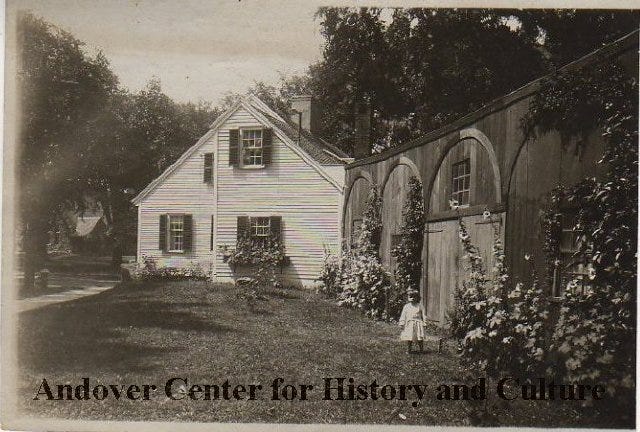It's Time for Tea!
The Rose Cottage Tea Room was a short adventure for this 240 year old house. For seven years – from 1906 to 1913 – Elizabeth “Lizzie” Marland ran the Rose Cottage Tea Room in the front room of the house.
Do you recognize the house? It sits on the corner of Central and Chestnut Streets.
AHS #1938.073.1
2 Chestnut Street was built in 1784 by Abner Abbot. The house passed through many owners, including Christ Church which used it as the rectory, until 1852 when it was purchased by Martha Lawton Marland Punchard. The house passed through various members of the Marland family until 1919. One resident, William S. Marland, left his mark on the house (still visible today!) when, as a child, he scratched his name on the window panes of the house.
In 1904, Lizzie and her husband Abraham Marland became the last of the Marland family to own the house.
In 1906, Lizzie altered the house to use it as a tea room. She installed latticed windows, boxed in the ceiling beams, and installed hardwood over the original wide pine floor boards to accommodate tea room foot traffic.
After her husband Abraham died in 1911, Lizzie and her son Harold continued to live in the house until 1913. They then moved and rented it to another resident.
The tea room closed shortly before the height of the small tea room craze during prohibition in the 1920s.
AHS # 1974.020.2
Lizzie Marland was at the forefront of the small independent tea room business. Owned by women, staffed by women, with a primarily middle class female clientele, independent tea rooms were a new business opportunity for women.
Tea Rooms: by Women, for Women
AHS #1980.106.1
Tea rooms were a step into independence for women entrepreneurs. Afternoon tea grew in popularity in the late 19th century, but most tea rooms at the time were in high end urban hotel restaurants, off limits to most middle class women.
Beyond the cost, an unaccompanied woman risked her reputation entering a restaurant without a male escort, because restaurants were associated with appetites of all kinds, not just food.
Because Americans were not as dedicated to tea as their British counterparts, independent tea rooms served more than just that beverage. Tea rooms were also known for serving simply-prepared, home-cooked meals.
From 1934 to 1937, Andover was home to another tea room, The Open Door Tea Room at 137 Main Street. Proprietress Lillian Seymore offered more substantial meals than Rose Cottage had, including Thanksgiving and other holiday dinners. She recruited bridge clubs and other women’s groups to meet at the tea room, and also did some catering.
And, in 1916, shortly after its founding in 1911, the Andover Historical Society offered Saturday afternoon tea in its first location on the corner of Main and Chestnut Streets.
The small independent tea room faded from American life in the mid-20th century. Mary Mac’s Tea Room in Atlanta, opened in 1945, is one of the only remaining tea rooms in the country.
You can read more about the Rose Cottage Tea Room on the Andover Stories page of our website. There's much more to the story of 2 Chestnut Street! You can find it on the Andover Historic Preservation website. Want to learn more about team rooms? Check out Tea at the Blue Lantern Inn: A Social History of the Tea Room Craze in America.








